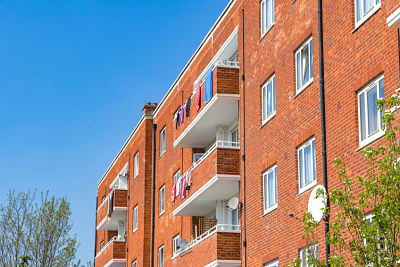
Did you know that UK homes are among the smallest in the world? The size of the average British house has been shrinking for decades, with homes now 20% smaller than in the 1970s. In urban areas where space is limited, there has been an increase in the construction of apartment blocks and shared living spaces as demand for housing in city centre locations has soared.
If you’re a UK landlord letting a small rental property, you’ll need to get creative and think smart when decorating and furnishing it to maximise its value. With a bit of careful thought, even the smallest of spaces can be turned into a stylish and functional space.
In this article, we’ve compiled useful tips and innovative ideas to help landlords maximise the appeal of even the tiniest of spaces.
The challenges of letting a small space
If your rental property is particularly small, it can present challenges for both you and your tenants. Making poor design choices or failing to address the challenges that living in a small space could present your tenants with, could significantly impact the success of your rental business.
Ultimately, your success as a landlord depends on how satisfied your tenants are with the quality of your property and the service you provide.
If you haven’t carefully considered the design and layout of your rental property, living in a small space could present your tenants with several challenges. Firstly, small spaces often lack storage space. If your tenants don’t have adequate storage space for tidying away their belongings, clutter can easily accumulate, turning a cosy living space into a chaotic and stressful environment. If tenants feel stressed and cramped at home, they’re likely to become unhappy and won’t want to stick around for long. Poor tenant retention rates can be costly, affecting both your rental income and reputation as a landlord.
The benefits of letting a compact living space
While letting out a small living space certainly has challenges, there are also plenty of benefits!
Not all renters are looking for big, spacious properties. For some demographics, a compact living space may be just the ticket! Single professionals, students, and young couples, in particular, may be drawn to small, cosy, and affordable rental properties that require less upkeep. Smaller properties may be more energy efficient and incur lower utility bills, an additional selling point for budget-conscious renters.
The benefits of compact living mean that intelligently designed small rentals are often highly sought after. Landlords letting small but perfectly formed properties often find that they are snapped up quickly and can achieve competitive rental rates for their size.
In addition, small properties tend to require less maintenance than larger ones, potentially reducing the time and money landlords spend on property management and upkeep.
Design tips for maximising space in small rental properties
Presentation is everything. A well-designed property can help you attract your ideal tenant, reduce tenant turnover, enhance tenant satisfaction, and maximise rental income – it’s key to your rental business’s success. And if the property you’re letting out is very small, it’s more important than ever!
Intelligent design can help make good use of every square inch in a small living space, making your rental property more appealing and comfortable for tenants.
We’ve compiled 11 essential design and layout tips for maximising space in a small rental property. These strategies help maximise living space, making even the smallest rental property feel more spacious, functional, and inviting.
Build in storage
As we’ve already discussed, one of the biggest challenges tenants face when living in a small space is where to keep all their stuff. If room sizes are very small, adding lots of furniture can reduce floor space further, leaving tenants feeling cramped and claustrophobic. One of the best ways to counteract this problem is to incorporate built-in storage solutions wherever possible. This could include built-in floor-to-ceiling wardrobes and cupboards or shelves in odd-shaped recesses or nooks to reduce wasted space.
Go open plan
If the rooms in your rental property are very small or odd sizes or shapes, it may be difficult for tenants to visualise living there or how they would arrange their furniture. Small rooms are also prone to feeling dark, enclosed, and claustrophobic. If this sounds like your rental property, consider whether it’s feasible to open up the space by knocking down walls and going open plan. Removing non-structural walls to create a single, larger living area can make a property feel lighter, airier, and more welcoming. An open-plan layout can enhance natural light and visual flow and provide more versatility for arranging furniture.
Install shelving and hooks
When floor space is limited, the walls can provide valuable storage space. Installing shelving and hooks can dramatically increase your property’s storage capacity without infringing on the living area. Shelves can be used for storing books, vinyl, games, décor, and plants, while hooks are perfect for hanging coats, bags, and even kitchen utensils.
Add a mezzanine level
While this strategy isn’t suitable for every property, adding a mezzanine is definitely worth considering if the structural conditions allow it. Unlike other space-maximising strategies that only create the perception of space, a mezzanine level actually increases the usable floor area. This addition could increase your rental property’s value and allow you to charge tenants more rent. A mezzanine is an intermediate floor – essentially a room within a room. Of course, the room must have quite high ceilings in order for a mezzanine to be a feasible option. Generally, the ceiling height needs to be at least 14ft to accommodate a mezzanine. While mezzanine levels can be used for many different purposes, they are most popularly used for sleeping. Installing a bed on a mezzanine level provides more space on the level below for storage, living areas or workspaces.
Multifunctional furniture
If you are furnishing your rental property, this is an excellent opportunity to really increase its functionality and maximise available space. Multifunctional furniture can transform small living environments by making more efficient use of space. Think tables and chairs that can be folded down, sofas and beds with built-in storage, and coffee tables and bedside units with drawers underneath. Before buying any furniture, always make sure you’ve carefully measured the room and opt for pieces that fit spaces perfectly with no space wasted on either side. Take care not to buy furniture that is too big for a room either, as oversized pieces can overwhelm a small room and make it feel cramped.
Sliding doors
In small properties where every inch of space matters, traditional swinging doors can take up valuable room. Replacing swinging doors with sliding doors can help save precious space, make a room feel larger, and allow for more flexible furniture placement. Sliding doors glide along a track instead of swinging open, meaning they don’t require any extra space for door clearance. Depending on which rooms the door is separating, you could even consider installing a glass sliding door to let in more natural light to help open up a small space,
Create more light
It’s a well-known fact that natural light can help to open up a small space and make it feel more spacious and airier. Therefore, it’s important to make light a key consideration in the design and layout of your rental property. Invite natural light in as much as possible by opting for light, airy curtains or blinds that can be fully retracted. When arranging furniture, make sure you position it to enhance, rather than block, the flow of natural light. If natural light is limited in your property, consider installing a skylight to brighten the space from above. If this isn’t possible, you can also introduce more light using strategically placed artificial sources. Combining overhead lights with task and accent lighting can mimic natural light and add a cosy warmth to the space.
Hang mirrors
Using mirrors to create the illusion of more space is one of the most effective and well-known interior design tricks out there! Mirrors reflect both natural and artificial light, making a room feel brighter and more open. They also reflect the view of the room, tricking the eye into perceiving a larger space. Placing a large mirror on a wall opposite a window not only increases the amount of light in a room but also reflects outdoor scenery and adds depth. If your rental property has a particularly narrow hallway or small entryway, adding a mirror can also help to widen the space visually.
Decorate in light, neutral colours
When decorating a compact rental property, it’s important to keep things as light and airy as possible. Forest green or navy blue walls may seem like a chic design choice, but dark colours like these can be overwhelming and claustrophobic in very small spaces. If your space is lacking natural light, dark colours will only make the space appear darker. Instead, decorating in light shades like white, cream, pale grey and beige will reflect more light, helping to brighten the room. These paler colours are also effective at creating a calm and welcoming atmosphere.
Minimalistic décor
When decorating a small space, less is always more. If space is limited, it’s important to keep décor as minimal as possible to prevent the environment from feeling cluttered and cramped once the tenant has moved all their belongings in. Minimalistic design favours simplicity and a monochromatic or neutral colour palette, which can make even the smallest of rooms feel more spacious and tranquil. Make sure that every piece of furniture or décor that you add to the property is there to serve a purpose or enhance the space aesthetically, and avoid adding excessive decorative items.
Design flexible spaces
People living in small rental properties with a limited number of rooms don’t always have the luxury of a separate office space or dining room. Therefore, it’s important to design flexible, multifunctional spaces. Consider incorporating design elements or furniture that can change function according to the time of day or the tenant’s needs. For example, a wall-mounted, drop-leaf table can be used as a dining area, a workspace, or folded away when not in use.
Demand for small rental properties is only set to rise as urban areas grow more populated and property prices continue to climb. However, compact living spaces are only appealing if they’ve been thoughtfully designed and offer a comfortable living environment. Investing a bit of time and thought into designing an attractive layout and maximising floor space can turn even the smallest of properties into a desirable and profitable rental home.



